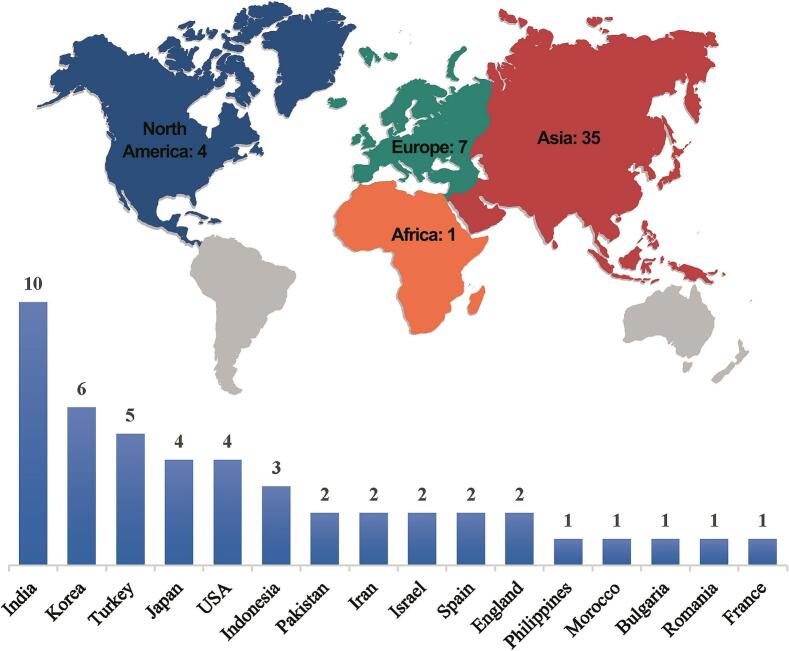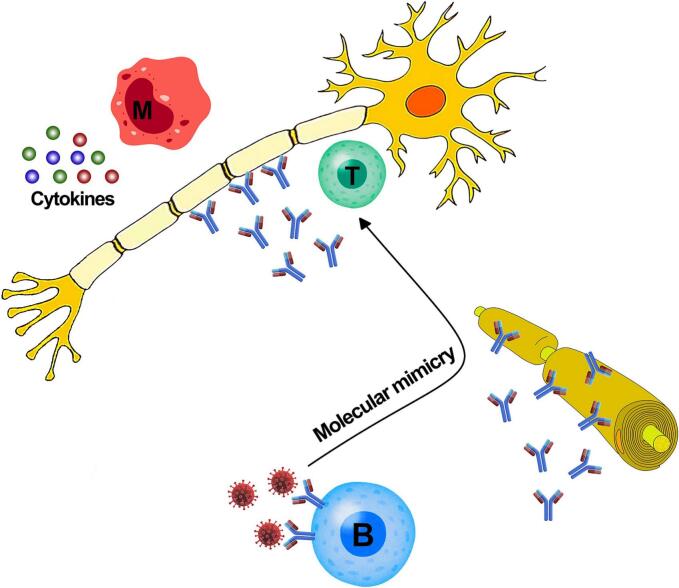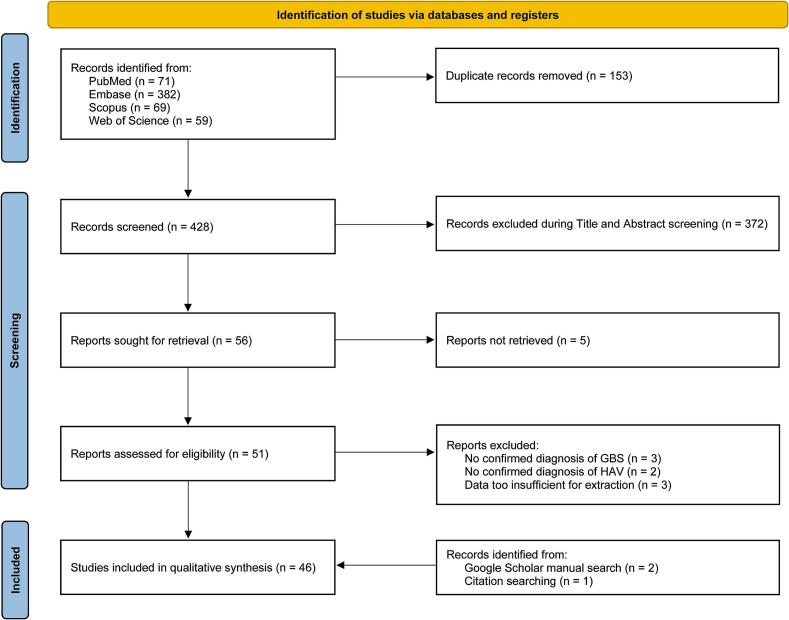a型肝炎病毒与格林-巴-罗综合征之间是否存在联系?对病例报告进行系统审查。
Q3 Neuroscience
引用次数: 0
摘要
格林-巴罗综合征(GBS)是一种周围神经系统炎症性疾病,可引起急性弛缓性麻痹。偶尔有报道将甲型肝炎病毒(HAV)与GBS联系起来。在这里,我们旨在评估目前关于GBS和HAV之间关联的文献,探索潜在的机制和临床意义。方法:我们在PubMed、Web of Science、Embase和Scopus中使用PRISMA指南进行了系统检索。仅包括已发表的病例报告或会议摘要,其中包括确诊的甲型肝炎感染和GBS病例。数据提取由两名审稿人独立完成,质量评估使用Joanna Briggs Institute关键评估工具进行。结果:在581项研究中,46项研究包括47例病例符合纳入标准。患者平均年龄29.47岁,男性居多(70.2%)。从地理上看,大多数病例报告在亚洲(74.5%)。HAV临床表现为发热、乏力、黄疸,GBS临床表现为肌肉无力、反射性屈曲。实验室结果显示76.2%的病例有白蛋白细胞分离。神经传导研究主要显示AIDP亚型(32/46,69.6%)。治疗包括IVIG、血浆置换和支持性护理,恢复时间从一周到18个月不等。据报道有一人死亡。结论:本综述提示甲型肝炎感染与GBS之间存在潜在联系,并提出了一种机制:分子模拟。它强调需要加强认识和预防措施,特别是在卫生标准较低的地区。然而,需要进一步的研究来阐明可能的机制并加深我们的理解。本文章由计算机程序翻译,如有差异,请以英文原文为准。



Is there a link between Hepatitis A virus and Guillain-Barré syndrome? A systematic review of case reports
Introduction
Guillain-Barré syndrome (GBS) is an inflammatory disorder of the peripheral nervous system, causing acute flaccid paralysis. There have been occasional reports linking Hepatitis A virus (HAV) to GBS. Here we aimed to evaluate the current literature on the association between GBS and HAV, exploring potential mechanisms and clinical implications.
Methods
We conducted a systematic search using PRISMA guidelines in PubMed, Web of Science, Embase, and Scopus. Only published case reports or conference abstracts presenting cases of confirmed HAV infection and GBS were included. Data extraction was performed independently by two reviewers, and quality assessment was conducted using the Joanna Briggs Institute critical appraisal tool.
Results
Out of 581 studies identified, 46 studies encompassing 47 cases met the inclusion criteria. The mean age of patients was 29.47 years, with a male predominance (70.2 %). Geographically, most cases were reported in Asia (74.5 %). Clinical manifestations of HAV included fever, malaise, and jaundice, while GBS presented with muscle weakness and areflexia. Laboratory findings showed albuminocytological dissociation in 76.2 % of cases. Nerve conduction studies predominantly indicated AIDP subtype (32/46, 69.6 %). Treatment involved IVIG, plasmapheresis, and supportive care, with recovery times ranging from one week to 18 months. One fatality was reported.
Conclusions
This review suggests a potential link between HAV infection and GBS, proposing a mechanism: molecular mimicry. It emphasizes the need for increased awareness and preventive measures, especially in areas with lower health standards. However, further research is needed to clarify the possible mechanisms and deepen our understanding.
求助全文
通过发布文献求助,成功后即可免费获取论文全文。
去求助
来源期刊

eNeurologicalSci
Neuroscience-Neurology
CiteScore
3.50
自引率
0.00%
发文量
45
审稿时长
62 days
期刊介绍:
eNeurologicalSci provides a medium for the prompt publication of original articles in neurology and neuroscience from around the world. eNS places special emphasis on articles that: 1) provide guidance to clinicians around the world (Best Practices, Global Neurology); 2) report cutting-edge science related to neurology (Basic and Translational Sciences); 3) educate readers about relevant and practical clinical outcomes in neurology (Outcomes Research); and 4) summarize or editorialize the current state of the literature (Reviews, Commentaries, and Editorials). eNS accepts most types of manuscripts for consideration including original research papers, short communications, reviews, book reviews, letters to the Editor, opinions and editorials. Topics considered will be from neurology-related fields that are of interest to practicing physicians around the world. Examples include neuromuscular diseases, demyelination, atrophies, dementia, neoplasms, infections, epilepsies, disturbances of consciousness, stroke and cerebral circulation, growth and development, plasticity and intermediary metabolism. The fields covered may include neuroanatomy, neurochemistry, neuroendocrinology, neuroepidemiology, neurogenetics, neuroimmunology, neuroophthalmology, neuropathology, neuropharmacology, neurophysiology, neuropsychology, neuroradiology, neurosurgery, neurooncology, neurotoxicology, restorative neurology, and tropical neurology.
 求助内容:
求助内容: 应助结果提醒方式:
应助结果提醒方式:


